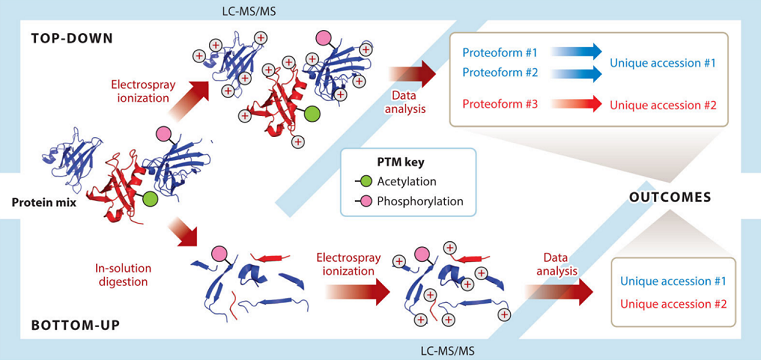Top Down Proteomics
Proteomics is considered a comprehensive technology for interpreting biological problems, involving a range of techniques including mass spectrometry (MS). Two main methods for protein identification and characterization via MS can be classified as 'bottom-up', which involves analyzing peptides through protein hydrolysis digestion, and 'top-down', which refers to the global analysis of intact fragmented proteins.

(Toby T K, et al.; 2016)
In bottom-up proteomics, proteins need to be digested into peptides before mass spectrometry analysis, while top-down proteomics uses separation techniques (e.g., liquid chromatography or 2-D gel electrophoresis) to separate intact proteins from complex biological samples, followed by MS analysis. Using soft ionization methods such as electrospray ionization (ESI) or matrix-assisted laser desorption ionization (MALDI), ions are generated through various dissociation methods, such as higher-energy collision dissociation (HCD), electron capture dissociation (ECD), and electron transfer dissociation (ETD), which are then analyzed by mass spectrometry. Bottom-up proteomics is a promising strategy for protein identification, analysis, sequencing, and post-translational modification (PTM) characterization, while the top-down approach allows MS analysis of intact proteins without enzymatic digestion, preserving features of proteins with unstable structures that are often disrupted in bottom-up strategies. Thus, data on modification sites and patterns can be obtained simultaneously in a single spectral analysis, providing insights into the relationships between these modification sites and patterns. Additionally, the absence of a protein digestion process reduces time consumption in the experimental process compared to bottom-up methods.

Based on top-down proteomics
Biotech company Biotage utilizes Thermo Fisher's Orbitrap Fusion Lumos mass spectrometer platform combined with nanoLC-MS/MS nanoflow chromatography, offering top-down proteomics services including protein sequencing, PTMs characterization, and protein structure characterization.
Top-down sequencing
Top-down MS can be used for both individual protein analysis and protein complex characterization. Under the top-down strategy, Biotage supports both N-terminal and C-terminal sequencing services, particularly when protein sample termini are modified or blocked.
Top-down PTMs characterization
The use of ECD and ETD for top-down mass spectrometry analysis has been successfully applied in proteomics research, especially for sequence mapping, identification of unpredicted PTMs, and determination of various modifications.
Protein structure characterization
Protein structure characterization helps in better understanding the function of proteins. Moreover, it plays an important role in biological development and quality control. Currently, MS is commonly used to determine the primary and higher-order structures of proteins. For instance, because no digestion process is applied to protein samples in their native state, the top-down approach can maintain and detect the quaternary structure with disulfide bonds.
Advantages of top-down proteomics
1. Relatively simple sample preparation
2. No protein digestion required
3. Direct detection of molecular weight of biological proteins
4. Extensive information retention, such as PTMs
5. Reduced time consumption
References
Toby T K, Fornelli L, Kelleher N L. Progress in top-down proteomics and the analysis of proteoforms[J]. Annual review of analytical chemistry, 2016, 9: 499-519.
Related Services
Top-down protein sequencing
Top-down PTMs characterization
Protein structure identification
Protein mass spectrometry identification
Shotgun proteomics identification
Quantitative proteome analysis
Targeted proteomics
Post-translational modification proteome analysis
4D proteomics
Proteomics bioinformatics analysis
How to order?





